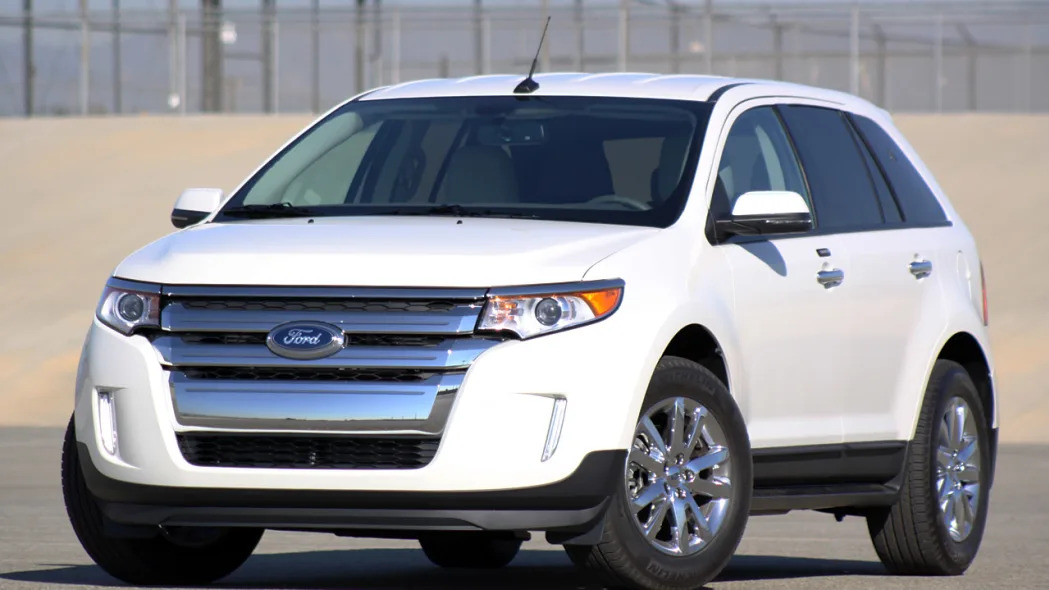Same New Skin, Big New Heart
Can you have your cake and eat it too? Ford thinks so. The Dearborn darling is in the middle of unleashing a slew of turbocharged, direct-injection engines for its products in North America, and we recently had a chance to sample a few. We were most interested, however, in one particular vehicle: the 2011 Edge equipped with Ford's new 2.0-liter four-cylinder EcoBoost engine. After some seat time with the Edge EcoBoost and a quick shake of our automotive journalist-issued Magic 8-Ball, we can confidently say Outlook Good for this Blue Oval-badged mid-size crossover. Outlook good, indeed.
Continue reading...
2011 Ford Edge EcoBoost - Click above for high-res image gallery
Can you have your cake and eat it too? Ford thinks so. The Dearborn darling is in the middle of unleashing a slew of turbocharged, direct-injection engines for its products in North America, and we recently had a chance to sample a few. We were most interested, however, in one particular vehicle: the 2011 Edge equipped with Ford's new 2.0-liter four-cylinder EcoBoost engine. After some seat time with the Edge EcoBoost and a quick shake of our automotive journalist-issued Magic 8-Ball, we can confidently say Outlook Good for this Blue Oval-badged mid-size crossover. Outlook good, indeed.
Continue reading...
Photos copyright ©2011 Jeff Glucker / AOL
The 2011 Ford Edge EcoBoost looks just like the refreshed 2011 Ford Edge Limited we drove earlier this year. The only difference on the outside is an EcoBoost badge on the rear hatch. It's essentially the same CUV with a very different motivational tool under the hood: a turbocharged, direct-inject 2.0-liter four-cylinder EcoBoost engine, a powerplant that Ford wouldn't let us photograph on the day of our drive. This same engine is currently on sale in Europe under the bonnet of the Ford Mondeo where it's rated at 200 horsepower and 221 pound-feet of torque.
The version we sampled was a pre-production North American unit, which we were told was still in the early stages of development. Power figures were simply stated as "230-plus horsepower" and "250-plus pound-feet of torque." Engineers on hand informed us they were still working to get every last bit of power from the highly tuned engine. The 2012 Ford Focus ST, which will utilize the same EcoBoost engine, is rated at 247 hp and 250 lb-ft of torque, so we expect similar numbers for the Edge EcoBoost as well. In comparison, the larger 3.5-liter V6 in the naturally-aspirated Edge produces 285 hp and 253 lb-ft of torque yet the EcoBoost unit is 55 pounds lighter .



Ford's 2.0-liter four-cylinder EcoBoost engine, like the 3.5-liter V6 and upcoming 1.6-liter four-cylinder, boasts a wide range of technology that helps push power and fuel economy numbers up while allowing for lower displacement and reduced weight. Working closely with Honeywell, Ford crafted a low-inertia turbo that spools up faster and helps eliminate lag. The direct-injection of the fuel allows for a higher compression ratio and a more efficient burn as well as reduced emissions. Timing on each cam, for both the intake and exhaust cycles, is adjustable thanks to the Ti-VCT (Twin Independent Variable Camshaft Timing), and this helps give the Edge the trademark flat torque curve that EcoBoost engines are noted for.
Understanding what's going on under the hood is one thing, but driving the Edge is where math and science meet the road. This may have been a pre-production powertrain, but we still wanted to see what it could do. The first thing we did was mash the gas pedal into the carpet. Power was sent to the front wheels and the result was surprisingly strong acceleration that left us with a Jack Nicholson-era Joker smile. There was no lag, just instant go. Like the larger, twin-turbo EcoBoost V6 we've sampled in so many other vehicles, the 2.0-liter manages to feel nothing like what its displacement and cylinder count suggest on paper.



Offering a four-cylinder as the Edge's premium optional engine sounds like crazy talk at first, but the bold decision makes some sense. Not only is power on par with the larger V6, but fuel economy is expected to improve anywhere from 10 to 20 percent. The front-wheel-drive V6-powered Edge is rated at 19 miles per gallon in the city and 27 mpg on the highway. With the EcoBoost, those numbers should rise to 20-23 mpg city and 30-32 mpg highway. It remains to be seen how many consumers are willing to pay more for similar power and better fuel economy out of a smaller powerplant, but if fuel prices rise as expected, this brave Blue Oval bet could just be a masterstroke.
Ford is putting a lot of time, money and marketing behind the entire EcoBoost family of engines, and by 2013, it will offer a variation of these turbocharged, direct-inject engines in 90 percent of its North American model lineup. Besides the 2.0-liter, we also sampled the 3.5-liter V6 and 1.6-liter four-cylinder, and the results mirrored each other. Their torque curves are flat and each model we drove them in surged toward the horizon with the same sense of urgency, be it the Edge, Flex or Fiesta.
In the case of the 2011 Ford Edge, however, adding the EcoBoost engine is like turning a circle into a sphere; the Edge was already exceptionally well-rounded, but now it excels in a whole new dimension.
Photos copyright ©2011 Jeff Glucker / AOL



Sign in to post
Please sign in to leave a comment.
Continue